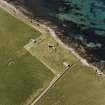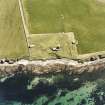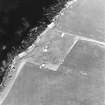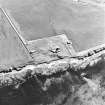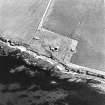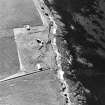Burray, Northfield Battery
Coastal Battery (Second World War), Gun Emplacement (Second World War), Magazine (Second World War), Observation Post (Second World War)
Site Name Burray, Northfield Battery
Classification Coastal Battery (Second World War), Gun Emplacement (Second World War), Magazine (Second World War), Observation Post (Second World War)
Alternative Name(s) Ayresdale
Canmore ID 81655
Site Number ND49NE 19
NGR ND 48473 98729
Datum OSGB36 - NGR
Permalink http://canmore.org.uk/site/81655
- Council Orkney Islands
- Parish South Ronaldsay
- Former Region Orkney Islands Area
- Former District Orkney
- Former County Orkney
ND49NE 19.00 48473 98729
For the Broch see also ND49NE 2
ND49NE 19.01 c.ND 4849 9873 Gun-emplacement; magazine
ND49NE 19.02 ND 48531 98730 Engine house
ND49NE 19.03 ND 48433 98697 Engine house (auxiliary)
ND49NE 19.04 ND 48590 98784, ND 48628 98786 and ND 48380 98736 Searchlight battery
This gun battery built adjacent to a broch (ND49NE 2) consisted of one twin 6 pounder, but was by July 1940 increased to two 6 pounder guns. The guns were removed in 1943. The associated buildings survive, but not in the usual layout.
J Guy 1993; NMRS MS 810/2.
ND 483 987 WWII searchlight emplacement.
ND 484 987 Burray battery: WWII coastal battery built into broch.
ND 485 987 WWII searchlight emplacement.
ND 486 987 WWII searchlight emplacement.
Sponsors: Historic Scotland, Orkney Archaeological Trust
G Wilson and H Moore 1997
A coast battery has been built into a broch (ND49NE 2) and is situated imemdiately above the shoreline between Brough Geo and Boats Geo, about 260m NW of Northfield farmsteading.
Built of shuttered and reinforced concrete, the gun-emplacement sits forward of the two storey observation tower. The gun-emplacement has a angled roof plan. Both viewing platforms of the tower have canopies.
The main gun-emplacement was armed with was armed in November 1940 with a twin 6-pounder, but earlier in that year a single 12-pounder had been installed (ND49NW 19.01) increased in July 1940 to two guns of this calibre. In March of 1941 one 12-pounder was moved to Holm Battery (HY40SE 12.00). The twin 6-pounder guns were removed during 1943 (PRO WO 199/527) to Graemsay Battery (HY20NW 26).
The battery also installed three searchlight platforms (ND49NE 19.04) an engine house (ND49NE 19.02), and an auxiliary engine house at c. ND 4846 9865.
Public Record Office documents show that the battery was designated in April 1941 as 139, and manned by 533 Regiment (WO 199/2627). The battery is visible on RAF vertical air photogrpahs (106G/Scot/UK 137, 3011-3012, flown 3 July 1946), which shows that there was a small accommodation camp of about nine huts situated 60m SE of the observation tower (c. ND 4852 9868).
Visited by RCAHMS (DE, GS), August 1999
Field Visit (August 1997)
This battery, located at the northern tip of Burray, guarded the waters of Weddell -sound in the years prior to the completion of Churchill Barrier #3. At the outset, the battery was armed with two twelve-pounder guns, both housed in temporary emplacements. In 1941 these were replaced with a twin six-pounder unit, housed in a concrete shelter with a directing tower. The battery continued in use until the end of 1943. The remains are described as encountered, moving from east to west:
(i) (ND 4865 9879) A concrete searchlight emplacement is positioned at the top of low, steep cliffs, facing out to Weddell Sound. It is entered through a break in the E side wall. Three long slit 'windows' at the seaward end originally served to disperse the beam of the searchlight.
(ii) (ND 4846 9873) The surviving remains include the twin six-pounder emplacement, its concrete shelter and directing tower - one of the temporary twelve-pounder emplacements - two engine rooms - a magazine and a shelter. Three searchlight emplacement are also associated with this battery. The fabric of all of the structures is showing signs of deterioration. Several of the structures have been reused as sheds and stores and some are presently inaccessible.
(iii) (ND 4856 9879) A concrete searchlight emplacement is positioned at the top of low, steep cliffs, facing out to Weddell Sound. It is entered through a break in the E side wall. Three long slit 'windows' at the seaward end originally served to disperse the beam of the searchlight.
(iv) (ND 4839 9874) A searchlight emplacement is set into the top of low, steep cliffs, facing out to Weddell Sound. It is entered via a set of four steps leading down to a break in the E side wall. The opening at the seaward end spans 180 degrees.
Moore and Wilson, 1997
Coastal Zone Assessment Survey



























